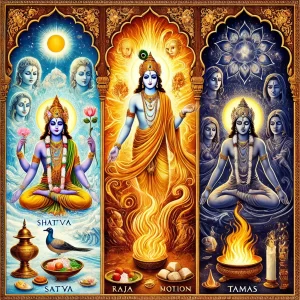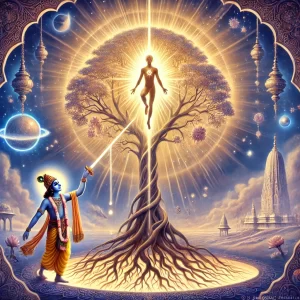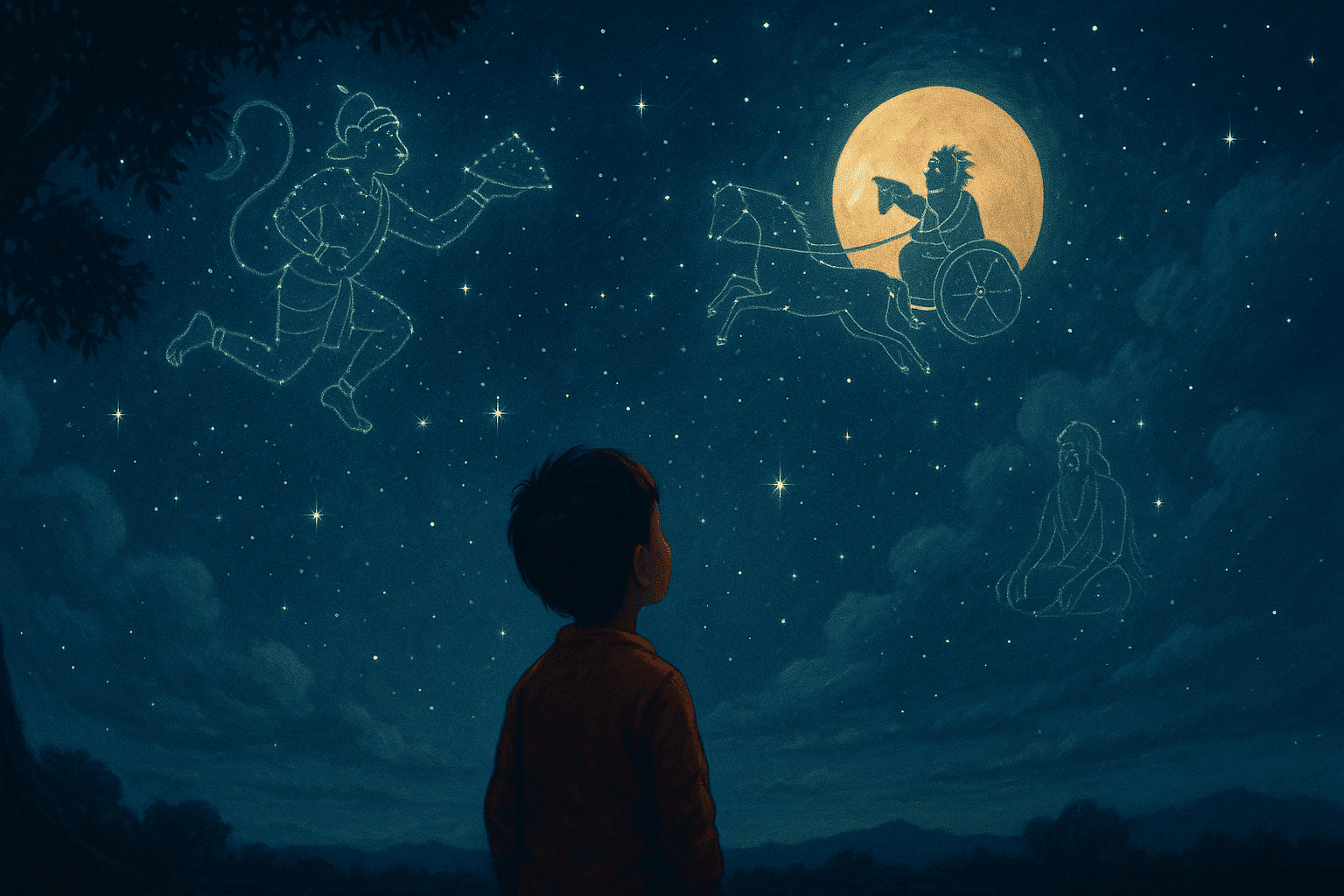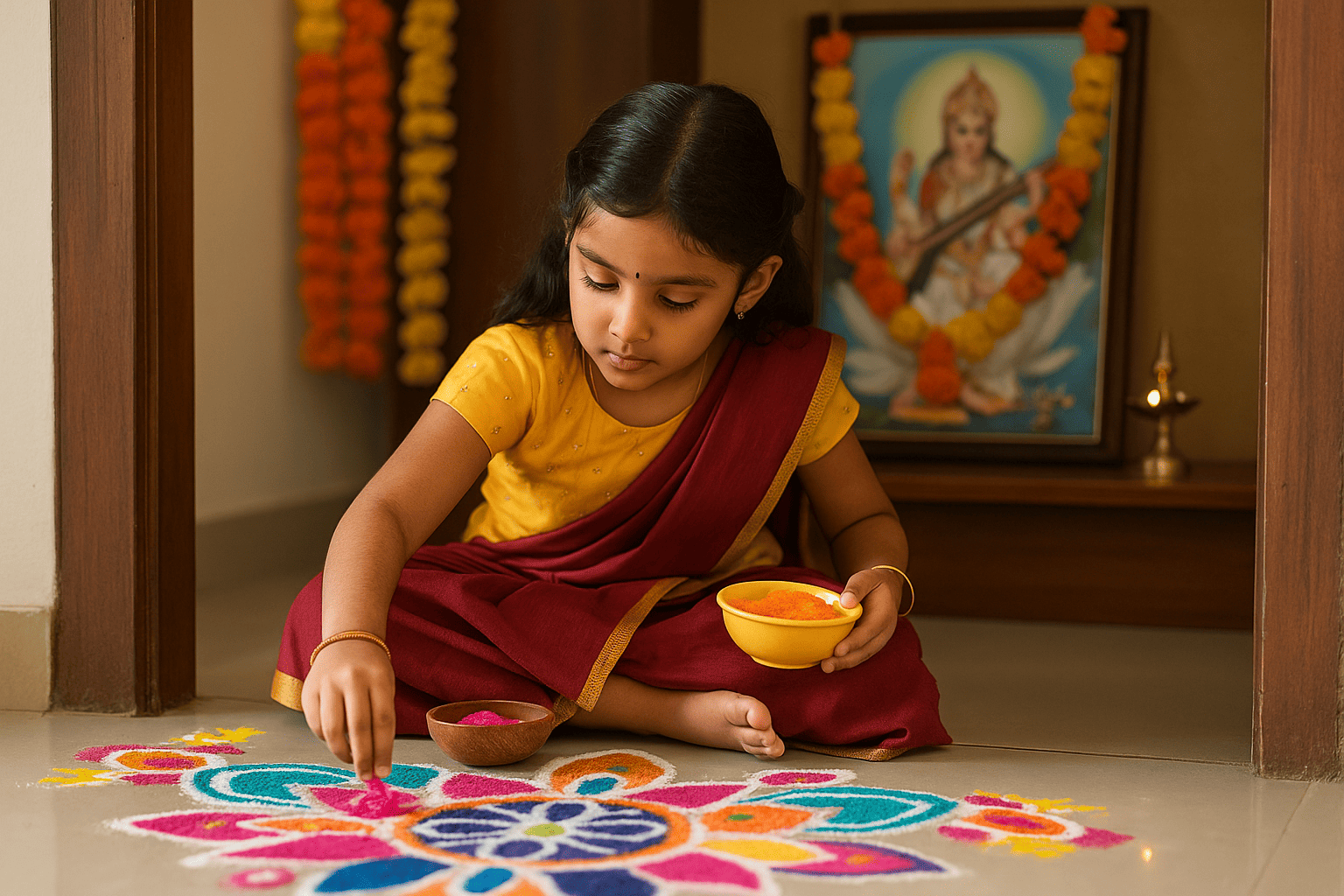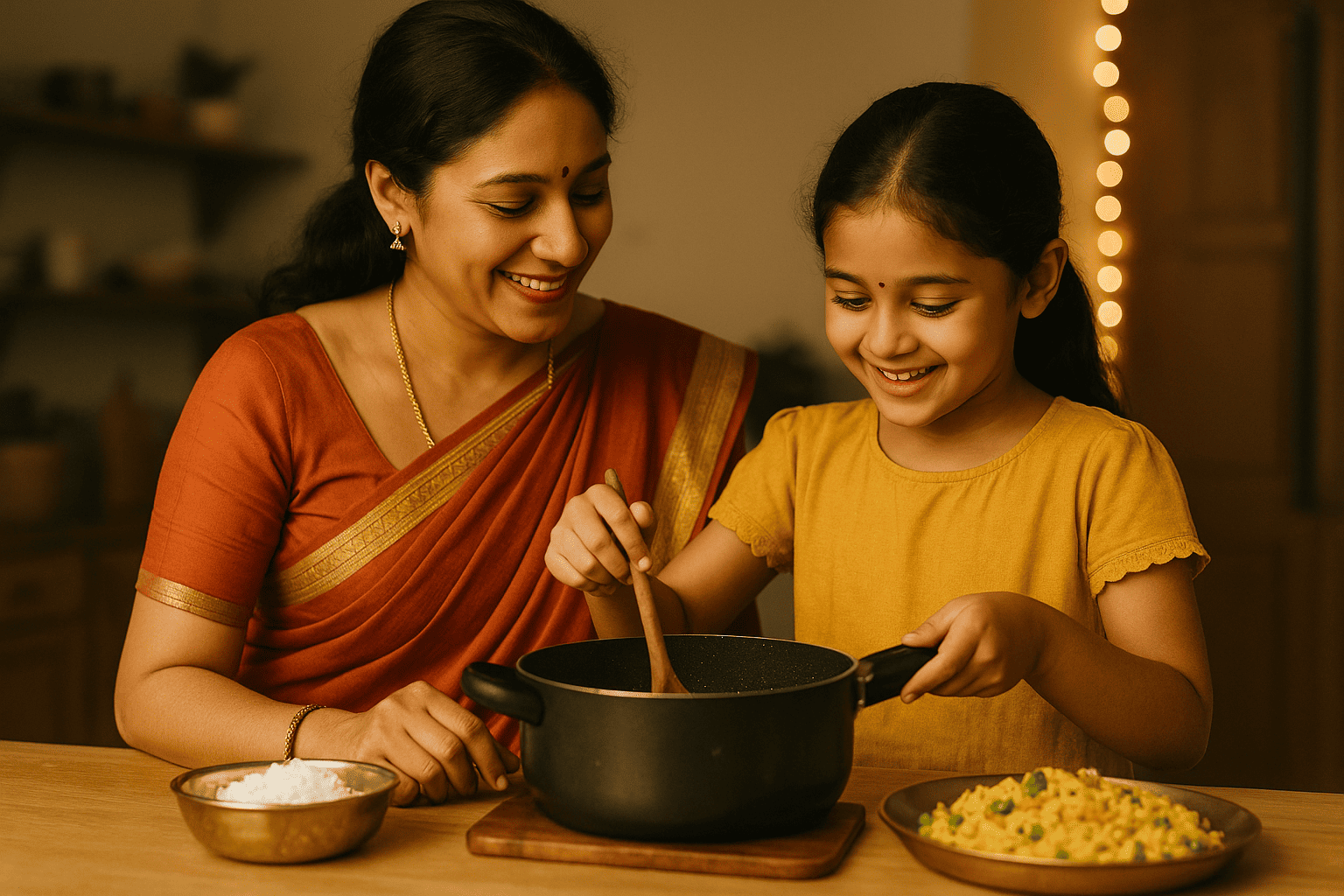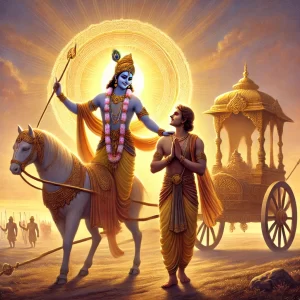
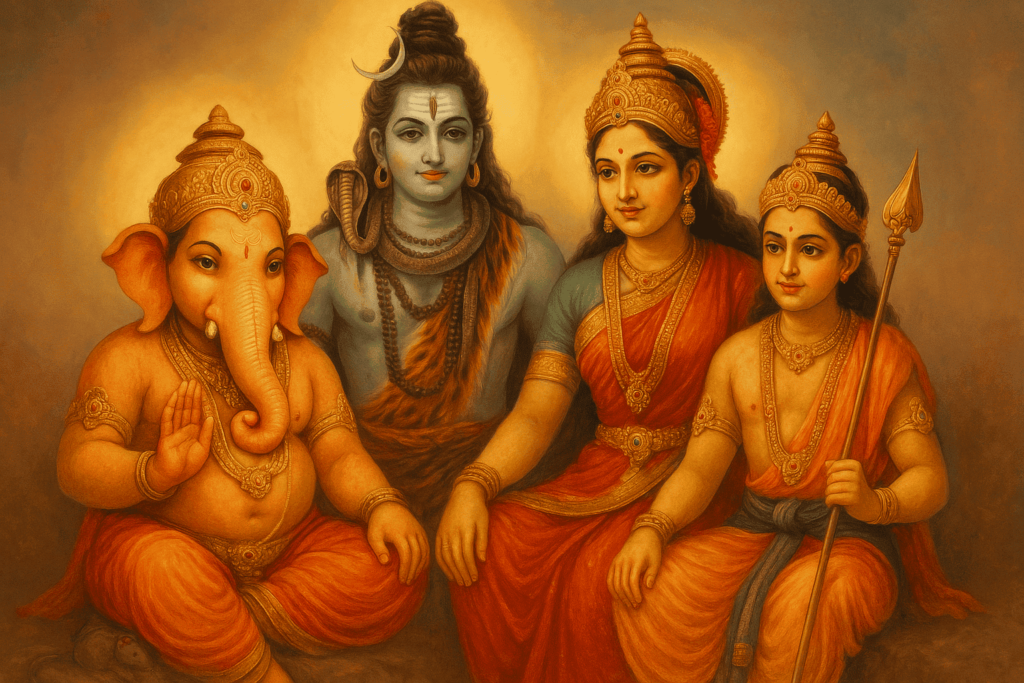
Once upon a time—before time even had a name—there existed a rhythm. A cosmic hum. It pulsed through the silence like a gentle heartbeat, soft yet eternal. There were no stars, no sky, no earth—just that vibration. And from this primordial sound came the first flickers of light, the stirrings of space, the birth of thought, and the earliest whispers of divinity.
It wasn’t a beginning marked by trumpets or thunder, but by the slow unfolding of a presence—ancient and endless. In this unfolding, forms emerged: not just one god, or one story, but many. A galaxy of beings, each carrying a purpose, a persona, and a place in the unfolding dance of existence.
Hinduism doesn’t start with a single god, a singular origin, or a fixed point. It begins like a sprawling epic, where divinity stretches across dimensions and time bends to the will of the sacred. In this vast cosmos, the gods are not aloof monarchs gazing down from distant heavens. They are family. They love and quarrel, bless and forgive. They are fathers and mothers, brothers and sisters, soulmates and seekers. Sometimes, they are reborn in different forms—looping through lifetimes to guide us again and again.
This “Hindu God Family Tree” isn’t a stiff, static diagram with names and lines—it’s a living, breathing story. It grows with every myth, blossoms with every festival, and whispers its wisdom through lullabies and prayers passed down for centuries.
So come—let us walk through this divine forest together. Let’s trace its ancient roots and branching tales—not just to see who connects to whom, but to feel the poetry in their bonds, the power in their stories, and the magic in their roles. Because to know this family is not just to understand the gods—it’s to recognize something sacred in ourselves.
At the very foundation of the Hindu cosmos lies the Trimurti—a sacred trio, not of siblings, but of cosmic expressions. Brahma, the creator, breathes life into the void. Vishnu, the preserver, ensures that life flows in balance. Shiva, the destroyer, lovingly clears the stage so creation may begin again. They are not competitors, nor do they occupy thrones in rivalry. They are three currents of the same eternal ocean—different, yet inseparable.
If the universe were a grand play, Brahma would pen the script in golden ink, shaping the scenes and characters. Vishnu would orchestrate the performance with grace and purpose, keeping every act in harmony. And Shiva? He would end the show, not in wrath, but in wisdom—so the story could start anew with deeper meaning.
Though all three are vital, only one among them opens the door to a world of deeply personal stories—of birth, childhood, marriage, mischief, and sibling love. Only Shiva, the wild ascetic with a serpent around his neck and a third eye that sees beyond illusion, becomes part of a family whose stories are sung in every home. A family where gods are not just worshipped, but loved—like a father, a mother, a brother, a child. A divine household where the cosmic becomes comfortingly human.
n the wild stillness of the Himalayas, where silence hums louder than sound, there sat Shiva—the great ascetic. Draped in tiger skin, adorned with serpents, and crowned with matted locks that held the sacred Ganga, he was a god beyond the pull of desire. He danced in cremation grounds, smeared in ash, lost in trance, untouched by the world’s illusions. He was time, death, and stillness personified.
And yet, into his austere world came Parvati—gentle, determined, radiant with inner fire. Born as the daughter of the mountain king, she was no ordinary princess. She was the reincarnation of Sati, Shiva’s first love, who had perished in the fire of heartbreak. But Parvati came not just to complete a love story—she came to awaken it again, from the ashes.
With unwavering devotion, she undertook fierce penance—through storm and sun, through hunger and solitude. Her resolve didn’t beg for love; it summoned it. For Parvati, this wasn’t about winning Shiva. It was about reminding him of a truth even he had tried to forget—that even the great destroyer needs balance, grounding, tenderness.
When Shiva finally opened his eyes, he didn’t just see a woman—he saw Shakti, the eternal feminine energy that moves the universe. Parvati was not merely his consort. She was his equal, his counterpart, his mirror. In her, the wild found calm, and in him, her gentleness found fierce protection.
Together, they formed the still point of the spinning cosmic wheel. And from this sacred union, two extraordinary sons were born—each carrying a spark of their parents, yet walking paths entirely their own.
One, a quiet sage with the head of an elephant. The other, a fierce warrior who rode a peacock into battle. Two brothers. Two gods. Two beloved children born of divine love and bound for divine purpose.
From the union of Shiva and Parvati came two sons—each as luminous as the other, yet carved from contrasting energies. They were not just siblings; they were reflections of life’s dualities—wisdom and action, stillness and motion, introspection and boldness.
Ganesha, the firstborn, emerged not from the cosmos but from Parvati’s own being—crafted lovingly from turmeric paste, shaped by her hands, and brought to life through her breath. His birth was an act of divine will, but his rebirth was a tale of heartbreak and redemption. Unaware of his origin, Shiva beheaded the boy guarding his wife’s door—only to learn too late that he had slain his own son. In remorse, he restored him with the head of an elephant, symbolizing strength, memory, and gentle power.
With his pot belly, calm eyes, and mischievous smile, Ganesha became the remover of obstacles, the guardian of thresholds, and the patron of new beginnings. He rides a tiny mouse, a symbol of humility, and devours laddus with boyish delight. But beneath his childlike charm lies a reservoir of wisdom deeper than the oceans.
Then there is Kartikeya—also called Murugan, Skanda, Subramanya—a god born for battle. His birth was no gentle affair. He was formed from the divine sparks of Shiva’s third eye, forged in fire, and raised by the nurturing hands of six celestial mothers. With a spear in his hand and a peacock as his mount, he descended to earth to slay demons that terrorized even the gods.
In northern tales, he’s a warrior prince. In Tamil traditions, he is the beloved deity—young, radiant, and full of resolve. Temples echo with chants of “Muruga!” and stories of his courage, intellect, and deep love for his devotees.
One brother dwells in contemplation; the other in motion. One teaches through silence; the other through valor. And yet, their bond is unshakable. At times they bicker—like when they race around the world to win a fruit of knowledge—but always, they return to one another with love and understanding.
Together, Ganesha and Kartikeya form one of the most cherished duos in Hindu lore. Their stories echo through generations—not just as tales of gods, but as reminders of the beauty of difference, the strength of family, and the balance we all seek between wisdom and courage.
If Shiva is the stillness at the end of time, Vishnu is the pulse that carries it forward. The great preserver of the universe, Vishnu does not tether himself to a single form or fixed place. Instead, he descends—again and again—into the fabric of the world, each time in a new form, to set right what has gone wrong. His avatars are not just acts of divine intervention; they are love letters to the world, promises that whenever dharma falters, he will return.
There are ten avatars, known collectively as the Dashavatara—from the fish that saved life from the flood, to the warrior Kalki who is yet to come. But among them, two avatars stand out like glowing constellations in the night sky: Rama and Krishna. Through them, Vishnu’s divine family tree takes root in the hearts and homes of millions.
In the kingdom of Ayodhya, under the golden rule of King Dasharatha, Rama was born—not just as a prince, but as a living embodiment of dharma. As the seventh avatar of Vishnu, Rama was more than just brave or righteous. He was balance itself—calm in crisis, steadfast in love, unwavering in duty.
His wife, Sita, born from the earth and full of grace, is believed to be the incarnation of Lakshmi, Vishnu’s eternal consort. Their bond is not one of grand romance, but of deep-rooted loyalty, patience, and spiritual partnership. In Rama and Sita, the divine plays out its most human expression—enduring exile, separation, temptation, and loss, all while holding fast to values.
Their story, the Ramayana, is not merely about slaying demons or crossing oceans. It is a timeless reflection on what it means to lead, to love, to lose, and still choose righteousness over revenge. In every corner of India, their names are whispered with reverence—not as distant gods, but as ideals to live by.
Then comes Krishna, the eighth avatar, and with him, the universe changes tempo. Where Rama is restraint, Krishna is play. Where Rama is rules, Krishna is rhythm. Born in a prison cell to Devaki and Vasudeva, carried across the Yamuna under stormy skies, and raised by Yashoda and Nanda in the pastoral village of Gokul—Krishna’s life is stitched with miracles and music.
As a child, he steals butter and hearts with equal ease. As a youth, he enchants the gopis with the sweet melody of his flute, and his eternal bond with Radha becomes the gold standard of divine love—pure, spiritual, and transcending the bounds of worldly union.
But Krishna is not just the playful boy of Vrindavan. He is also the statesman of Dwarka, the friend and charioteer of Arjuna, the voice of cosmic truth in the Bhagavad Gita. His words, spoken on the battlefield of Kurukshetra, echo through time as a guide to purpose, detachment, and the soul’s eternal nature.
Krishna’s life is a tapestry of contradictions: mischief and wisdom, flirtation and philosophy, tenderness and strategy. His wives—Rukmini, Satyabhama, and others—are reflections of love in its many hues, while his sons and kin weave further into the epic of the Mahabharata.
In Rama and Krishna, Vishnu does not simply act—he lives. He feels the pain of exile, the joy of love, the burden of kingship, and the silence of cosmic truths. Through them, divinity walks barefoot on earth, reminding us that gods too have families, choices, and destinies—and that through their stories, we may come to understand our own.
Here, the family tree takes a softer, more poetic turn—less about bloodlines, more about balance. In the vast celestial weave of Hinduism, not all relationships are born of lineage; some are born of essence. Lakshmi, the goddess of wealth and fortune, and Saraswati, the goddess of knowledge and wisdom, are often seen as divine sisters. Their origins may differ from text to text, their stories shaped by the telling—but their presence together in the spiritual imagination is unmistakable.
They are not always tethered to the same household in myth, but they dwell side by side in the hearts of devotees—one guiding the hands, the other guiding the mind. Together, they form a sacred duet: the power to create abundance, and the discernment to use it wisely.
Lakshmi is the eternal consort of Vishnu. In every one of his avatars, she returns—not just as a companion, but as a stabilizing force. As Sita beside Rama, she endures exile with grace. As Rukmini with Krishna, she brings royal strength and quiet devotion. Her gifts are not only of gold or grain, but of harmony, beauty, and the blessings that make a home feel whole.
Saraswati, meanwhile, moves to a different rhythm. She is often linked to Brahma, sometimes as his creation, sometimes as his muse, occasionally even as his daughter. But Saraswati rarely stays. She is the river of inspiration, flowing where she will. Unlike Lakshmi, she is rarely portrayed as a wife or mother. Instead, she belongs to no one and to everyone, forever immersed in the pursuit of truth, melody, poetry, and thought.
Clad in white, seated on a lotus or a swan, veena in hand and scriptures by her side, Saraswati is less a figure in a family drama and more the quiet presence behind every song, every verse, every idea that lights up the mind.
And yet, when people pray for a complete life, they call on both: Lakshmi for prosperity, Saraswati for clarity. One fills the home; the other fills the heart. In this way, though they may not share a family tree in the literal sense, they are bound by a deeper, timeless kinship—a cosmic sisterhood of purpose and presence.
At first glance, Parvati is the picture of grace—gentle consort of Shiva, nurturing mother of Ganesha and Kartikeya, the quiet strength behind the cosmic dance. But within her calm exterior lies a storm. She is not just love; she is power. And when the world is threatened, when darkness dares to rise too high, she does not wait for rescue—she becomes the rescuer.
From her inner fire emerges Durga—the invincible warrior goddess, born not of fear but of fierce purpose. With ten arms wielding divine weapons, riding a lion that roars with righteousness, Durga is not an extension of a god—she is a force all her own. She charges into battle against Mahishasura, the buffalo demon, not as a helper, but as the only one who could end his reign of terror. She is strength cloaked in beauty, serenity sharpened into strategy.
But even Durga has a limit. When rage overflows, when injustice pushes past the edge of balance, she transforms yet again—this time into Kali. Dark as the void before creation, hair unbound, tongue outstretched, garlanded with skulls and eyes blazing like stars about to collapse—Kali is the goddess no evil dares to name. She doesn’t just defeat demons; she devours them. She dances on the battlefield in a trance of destruction, until Shiva himself must lie at her feet to still her storm.
And yet, these are not forms to be feared—they are forms to be revered. Durga and Kali are not contradictions to Parvati—they are her truths, magnified. Where Parvati nurtures with patience, Durga protects with strength, and Kali awakens with raw, primal power. Together, they remind us that divine femininity is not just soft—it is sovereign.
Though not always part of a literal family lineage, Durga and Kali are the spiritual foremothers of countless goddesses, from regional deities to village protectresses. They live in the strength of every woman who stands her ground, in every mother who becomes a shield, in every voice that refuses silence.
They are the eternal message whispered through generations: that love and rage, creation and destruction, nurturing and fearlessness—are not opposites, but powers that flow from the same sacred source.
As we step beyond the central divine households of Shiva and Vishnu, the sky opens wider—to welcome the radiant kin who ride the heavens and shape the rhythm of time itself. Among them shine the celestial luminaries: Surya, the sun god, and Chandra, the moon god. Though not always central in mythological narratives, their roles ripple through the family lines like beams of light across water—subtle, essential, and eternal.
Surya, the blazing guardian of day, soars across the sky in a golden chariot drawn by seven horses—each one representing the seven colors of light, the seven days of the week, the seven chakras of the body. He is not just a sunbeam; he is consciousness itself, illuminating life and revealing truth. But Surya is more than a solitary force. He is also a father.
His children span myth and meaning—Yama, the god of death and righteous judgment, who patiently waits at the doorway of every soul’s journey. Shani, the stern deity of karma and discipline, whose slow movement across the heavens reflects the long arc of justice. And then, from a more earthly tale, Karna—the noble yet doomed hero of the Mahabharata, born of Kunti before marriage, gifted with divine armor and an unwavering sense of honor. Karna’s birth, a spark from Surya’s grace, reminds us that even the brightest souls can walk the loneliest roads.
Then, bathing the night in silver light, comes Chandra, the moon god—serene, elusive, ever-changing. Where Surya burns, Chandra soothes. His crescent graces Shiva’s matted hair, and his glow is believed to cool the fire of the mind. But Chandra is not merely a celestial ornament—he is a patriarch in his own right.
Through him flows the Soma Vamsa, the lunar dynasty, a line of kings and heroes that stretches like a river across generations. And from this lineage would one day be born Krishna, the eighth avatar of Vishnu—a god who dances, loves, fights, and teaches. Krishna’s family tree, traced back to Chandra, becomes the trunk from which the epic of the Mahabharata grows.
From Krishna’s house emerges another set of celestial cousins: the Pandavas, sons of gods themselves, born to uphold dharma in an age of chaos. Through marriage, war, and fate, their stories intertwine with those of Surya and Chandra, weaving a web where even the stars feel like kin.
So even in the farthest reaches of the divine tapestry, we find no outliers. The sun, the moon, the planets—they are not just in the sky—they are part of the family. Their light touches the faces of gods, kings, sages, and mortals alike. They remind us that the cosmos is not a distant machine, but a living lineage, filled with warmth, rhythm, and relationship.
In Hindu thought, even the heavens are bound by love.
In the vast tapestry of Hindu mythology, nowhere does the line between god and human blur more beautifully than in the Mahabharata—an epic not only of kings and kingdoms, but of dharma, destiny, and divine descent. Though the stage is set in royal courts and blood-stained battlefields, the characters walk with the echo of celestial footsteps behind them. They are mortal, yes—but their blood carries whispers of the gods.
The five Pandava brothers are born of Queen Kunti and Madri, but fathered by deities, summoned through sacred mantras in times of desperation and hope.
Even Karna, their fiercest rival and most tragic mirror, shares their lineage. Born to Kunti before her marriage, his father is Surya, the sun god. Though raised by a humble charioteer, his nobility, generosity, and undying loyalty shine with a light all his own.
And standing among them—not merely as an advisor, friend, or charioteer—but as the divine himself, is Krishna. Cousin to the Pandavas and Kauravas alike, he walks the earth as Vishnu incarnate, yet laughs, speaks, strategizes, and bleeds like any man. In his presence, the epic gains its soul. Through him, the battle becomes more than war—it becomes a conversation between fate and free will, between illusion and truth.
The Kauravas, too—born of magic, grown from clay pots and divine blessings—are part of this same tangled destiny. Though remembered for their pride and ambition, they are no less bound by the pull of karma and the strings of cosmic design.
In this great war of cousins, it is not simply good versus evil—it is the clash of choices, the weight of dharma, the sorrow of family torn by ideology and ego.
And so the Mahabharata reminds us: the gods do not only reside in the heavens—they walk beside us, live within us, and emerge through our decisions. The sacred and the earthly are not two worlds—they are threads in the same epic song, playing out across time in the form of heroes, sons, lovers, kings, and warriors.
Through the Pandavas and their divine ancestry, we are shown a truth that pulses at the heart of Hindu thought—that the gods live not above us, but through us.
In most traditions, a family tree grows in one direction—branching upward from roots toward generations yet to come. But in Hinduism, the divine family tree doesn’t just grow—it cycles. It turns like a wheel, spinning through lifetimes, births, and ages. Gods do not remain fixed in one form or frozen in one moment. They return, again and again, slipping into new names, new stories, new relationships—all while carrying the same eternal essence.
In this grand cycle, Lakshmi, the goddess of abundance, takes many forms. As Sita, she walks beside Rama through forest and exile. As Rukmini, she stands steadfast with Krishna in palace and war. As Radha, she dances in the forests of Vrindavan—not as a wife, but as a soul eternally bound to its source. Each is not a separate goddess, but a different face of the same love, the same devotion, the same divine feminine light.
Vishnu, too, returns—not just as Rama or Krishna, but as the protector, molded to the needs of the age. He carries a bow in one life, a flute in another, and still the same promise in both—to uphold dharma, restore balance, and guide humanity with compassion and clarity.
And Parvati, the mother goddess, the consort of Shiva, returns in vibrant forms across time and region. As Meenakshi, she rules Madurai with wisdom and valor. As Kamakshi, she radiates compassion from Kanchipuram. As Annapoorna, she offers nourishment to both body and soul. In each birth, her essence remains—strong, nurturing, fierce, and ever-present.
These are not isolated lives but re-threadings of the same soul, stitched into the fabric of time and culture. They appear when they are needed, in the forms that hearts can recognize, and in the languages that souls can hear.
The Hindu view of divinity is not linear—it is circular, expansive, alive. The gods do not simply exist in the past or hover in the heavens. They return. They walk with us. They become part of our lives again and again, reminding us that divinity is not bound by time—it is time’s companion.
In this way, the family never truly ends. It reappears. It grows not just by lineage, but by memory, myth, and meaning—always ready to teach, to love, and to lead us back to the truth we’ve known all along.
So, what does it truly mean to understand this cosmic family tree—not just in names and connections, but in spirit?
It means realizing that the divine is not distant or untouchable. It isn’t locked away in temples or reserved for rituals. Instead, it lives in stories that feel oddly familiar—in laughter, misunderstandings, courage, and heartache. The gods of Hinduism do not hover above us in perfection; they walk beside us in imperfection, in choices, in growing pains.
They argue, they fall in love, they struggle with pride, and they weep for their children. They forgive. They return. In doing so, they show us that the spiritual journey is not about being flawless—it’s about being present, being honest, being real.
Their stories are not commandments; they are mirrors. Through Ganesha and Kartikeya, we learn that even divine siblings can compete, quarrel, and still love fiercely. Through Sita and Rama, we see the weight of expectations, the ache of exile, and the beauty of enduring love. Through Krishna’s childhood, full of butter thefts and mischievous smiles, we’re reminded that divinity can be playful, tender, and full of joy.
These tales don’t lecture—they invite. They make room for children to wonder, for parents to reflect, and for all of us to find fragments of ourselves in celestial characters. They turn grand theology into something as intimate as a family gathering—sometimes loud, sometimes silent, sometimes messy—but always meaningful.
And perhaps that’s the greatest gift of all: the reminder that even gods are in process, evolving through lifetimes, growing through relationships. If they can transform, then so can we.
In the branches of this family tree, we don’t just find gods—we find ourselves.
This divine family tree is not carved in stone, sealed in scripture, or confined to temples. It breathes. It evolves. It grows quietly in the spaces between prayer and story, expanding not just across time, but across cultures, languages, and the hearts of those who carry it forward.
Every region, every village, every family adds a new leaf to its branches. In Bengal, the tree blooms each year when Durga returns—not just as a goddess, but as a daughter coming home, arms full of love and weapons alike, with her children beside her and her devotees waiting with open arms.
In Tamil Nadu, it is Murugan, the eternal youth and valiant son, who takes center stage. His six sacred abodes, the Aaru Padai Veedu, draw millions each year—not just to seek blessings, but to feel the rhythm of a divine son who never truly left.
In Maharashtra, the devotion flows through Vithoba and Rakhumai, quiet incarnations of Krishna and Rukmini, who stand patiently on temple stones, listening to the simple songs of farmers, saints, and seekers. There, love is not thunderous—it is still, enduring, and close enough to touch.
And so, this tree doesn’t only grow upward, chasing celestial heights—it grows inward, rooting itself in daily life. It blossoms in lullabies sung to children, in kolams drawn at dawn, in lamps lit during dusk prayers, and in the stories whispered by grandparents who remember gods not as distant beings, but as old friends.
It is a tree watered by devotion and warmed by memory. A tree that doesn’t just tell us where the gods come from—but reminds us where we belong. In every home where faith flickers gently, in every heart that holds a story sacred, the divine family tree continues to grow—one story, one soul at a time.
The Hindu God family tree is not a chart of names to memorize, or a tangle of mythologies to decode. It is a map of belonging—a living, breathing guide to the human heart and the divine spirit. Every branch carries not just the lineage of gods, but the legacy of values. Every leaf whispers not just ancient names, but timeless truths.
And perhaps the most powerful realization of all is this:
You are part of that tree.
Every time you light a diya, every time a child listens wide-eyed to a tale of Ganesha or Krishna, every time you fold your hands in prayer or hum a mantra at dawn—you’re not just practicing a tradition. You’re nourishing the roots. You’re feeding the soil of a tree that has stood tall for millennia, weathered storms, and yet never stopped blossoming.
This isn’t a family tree built on hierarchy. It’s built on connection—between gods and mortals, between the past and the present, between the sacred and the everyday. It’s a tree that offers shade in moments of confusion, fruit in times of longing, and stories in moments of silence.
So let it grow in you.
Let its wisdom curl around your questions. Let its stories echo in your celebrations. Let it remind you that faith is not distant—it is familiar, not rigid—it is alive.
Because in the end, the divine doesn’t just live in temples or scriptures—it lives in you.
And through you, the tree keeps growing.

